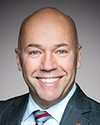Thank you.
We have a myriad of programs, and I am glad to see that CIHR is starting to really focus, because I think that is going to be critical. Aboriginal head start has been around forever, as well as the NNADAP program. Programs have been around, and if they are not working, I think we need to start to refocus support. Obviously, the biggest issue is the upstream.
Again, hopefully my next question is a quick one. In the headlines this morning, in the Ottawa Citizen, was a young indigenous person who was clearly having challenges. The doctor was so horrified that she felt she had to speak out. You talked about the mandate of working with the provinces and territories. When those sorts of things happen, do you ever take an incident like this and give that doctor a call to say, what the heck is going on? Do you have a system in place with the provinces where you can use a case study like that to improve things? Did you pick up the phone, or did anyone in your department pick up the phone? Apparently, it sounded very horrific in terms of a local case.



